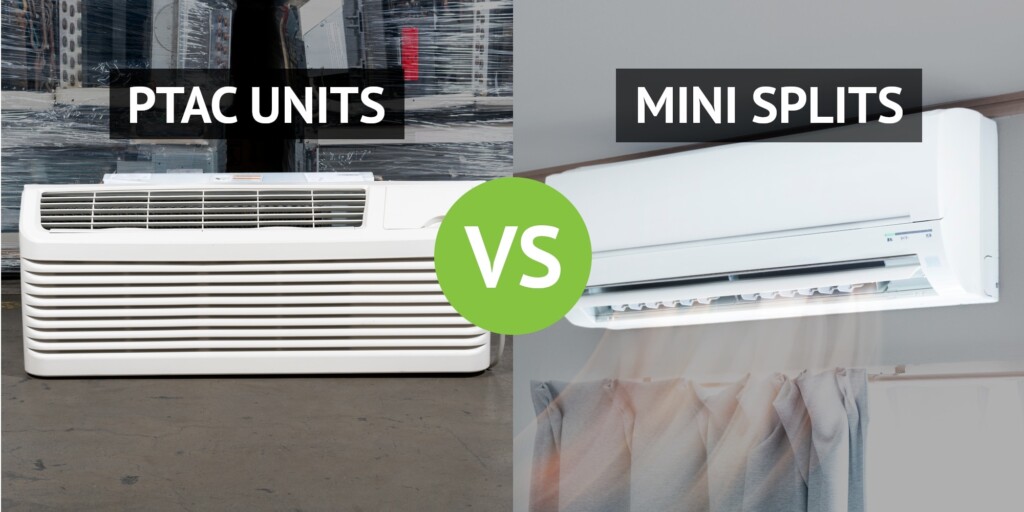When it comes to heating and cooling solutions for your space, both PTAC (Packaged Terminal Air Conditioner) units and mini splits offer their unique set of advantages. In this article, we’ll delve into the reasons why you might consider using a PTAC unit and how it compares to mini splits. By examining the pros and cons of each system, you can make an informed decision that best suits your needs.

PTAC Units: Pros and Cons
Pros:
- Versatility and Ease of Installation: PTAC units are designed for individual room cooling and heating, making them suitable for single spaces or multi-room applications. They are relatively easy to install, especially in existing buildings or hotel rooms where ductwork may not be present.
- Cost-Effective Solution: PTAC units are generally more affordable upfront compared to installing a central HVAC system. They provide efficient temperature control for individual spaces, allowing you to adjust the climate according to specific requirements.
- Energy Efficiency: Many modern PTAC units are equipped with energy-saving features, such as programmable thermostats and occupancy sensors, which help optimize energy usage and reduce utility costs.
- Quiet Operation: PTAC units typically operate quietly, making them ideal for residential spaces, hotel rooms, or offices where noise can be a concern.
Cons:
- Limited Aesthetic Appeal: PTAC units are visible within the room, mounted either through the wall or below a window. Some individuals may find them less visually appealing compared to concealed ducted systems or mini splits.
- Limited Zoning Control: PTAC units provide localized temperature control for individual rooms but may not offer the same level of zoning flexibility as mini splits. Each PTAC unit typically serves one space, which may require multiple units for comprehensive climate control in larger buildings.
Mini Splits: Pros and Cons
Pros:
- Zoning Flexibility: Mini splits offer the ability to create multiple zones within a building, allowing for customized temperature control in each area. This can result in energy savings by avoiding unnecessary heating or cooling in unoccupied spaces.
- Improved Energy Efficiency: With their advanced inverter technology, mini splits can modulate their operation to match the desired temperature, resulting in energy efficiency and reduced utility bills.
- Aesthetic Appeal: Mini splits comprise two main components: an indoor unit and an outdoor condenser. The indoor unit can be mounted high on a wall or recessed into the ceiling, providing a sleek and unobtrusive appearance.
Cons:
- Higher Initial Investment: Mini splits tend to have a higher upfront cost compared to PTAC units, mainly due to the requirement of an outdoor condenser unit and the need for professional installation.
- Complex Installation: Installing a mini split system involves running refrigerant lines and electrical wiring between the indoor and outdoor units. This process can be more complex and time-consuming compared to installing a PTAC unit.
- Limited Individual Room Control: While mini splits offer zoned control, individual room temperature adjustments may require accessing the unit or using a remote control. This can be less convenient compared to PTAC units, which often have built-in controls within each unit.
Conclusion:
Both PTAC units and mini splits have their advantages and considerations. PTAC units offer versatility, cost-effectiveness, and ease of installation, making them a popular choice for individual room temperature control. On the other hand, mini splits provide zoning flexibility, enhanced energy efficiency, and aesthetic appeal, but typically come with a higher initial cost. Consider your specific needs, budget, and preferences to determine which system aligns best with your requirements.
Please note that the information provided in this article is intended to give a general overview of the pros and cons of PTAC units and mini splits. It’s advisable to consult with a professional HVAC specialist to assess your specific situation and receive expert advice tailored to your unique needs.
As an Amazon Associate we earn from qualifying purchases through some links in our articles.



